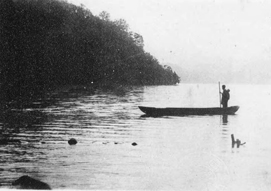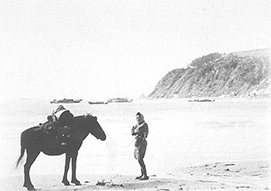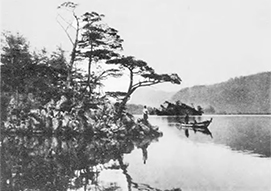Column <Tohoku>
7 Hachirogata Lagoon
Hachirogata Lagoon was once the 2nd biggest lake in Japan with a surface area (approximately 22,000 ha) second only to Biwa Lake. It is a brackish water lake where sea water and fresh water mix, with a shallow depth of only 3-5 m.
The sight of the lake before reclamation by drainage can still be seen in the photo, and as shown by the boats visible scattered in the background, it was once a prosperous fishing location. In the summer could be seen white sailed ships dragging utaseami (a type of dragnet), and in the winter there was the scene of ice fishing, and the lake smelt and other fish that could be caught were prepared by being boiled down in soy sauce.
The legend of Hachirogata Lagoon
The name of "Hachirogata" comes from the story of Hachirotaro. Hachirotaro was born in Kazuno no Sato (Kazuno Village, the present-day Kazuno-shi (Kazuno City)). One day, Hachirotaro went with two of his friends deep into heart of the mountains in Towada. While his friends were away, Hachirotaro caught and was frying three char, when he became so hungry that he could not help himself and not satisfied with only his own portion, he ate all three fish, including his friends' portions. When he did this, his throat began to be irritated, as if it had been burned, and he began to want water so badly he could not stand it. As he continued to drink water from the river, he slowly changed and in the end had turned into a dragon. Frightened by his own changed shape, and realizing he could no longer return to his village, he bid his friends farewell. He then stopped up the mountain stream to create a lake, and began to live there. It is said that this was Towada Lake.

- Tazawa Lake "Tazawako Annai"
Thereafter, an ascetic monk named Nansobo came to Towada Lake. Nansobo had been told in Kumano (present-day Wakayama-ken (Wakayama Prefecture)) that he should, "live in the place where the thong of his sandals breaks", and as the thong of his sandals had just broken, he thought to live at Towada Lake, however Hachirotaro, the current master of the lake, had not yet given up his place. After a fierce battle, Hachirotaro lost and swam down to the Yoneshiro River, and after finally arriving at the Amase River, he created Hachirogata Lagoon and made it his new home. Hachirotaro was later united with Tazawa Lake's Tatsuko (a girl who had changed from a human into a dragon like Hachirotaro), and would then live in Tazawa Lake during the winters. It was said that without its master, Hachirogata Lagoon would freeze in the winter, but Tazawa Lake would not freeze even during the winter, and with two dragons living there, the lake was constantly made deeper and deeper (Tazawa Lake is the deepest lake in Japan, with a maximum depth of approximately 420 m).
The reclamation of Hachirogata Lagoon
This region often suffered from rice shortages due to cold-weather damage, and there were plans to reclaim the shallow Hachirogata Lagoon from as early as the Edo period. During the Ansei era there was Watabe Onomatsu's "Plan to Irrigation Channel Hachirogata Lagoon", and in 1872 there was the governor of Akita prefecture Shima Yoshitake's "Hachirogata Lagoon Development Plan", and thereafter a plan was also created by the Ministry of Agriculture and Commerce. , in addition to technological problems, the plans required large amounts of money, and so the implementation was always put off.
However, in the postwar period a reclamation plan was again put forth for the purpose of increasing food production. Prime Minister Yoshida Shigeru's strong ambitions were said to be behind this plan, aimed at simultaneously resolving the issue of lack of work for 2nd and 3rd sons of farmers due to lack of arable land, as well as improved diplomatic relations with the Netherlands through a land reclamation project. In March of 1954, professor Jansen and engineer Volker came to Japan from the Netherlands at the request of the Japanese government. A new reclamation plan was created based on the past Japanese plans, and work commenced in 1957.
There was of course resistance to the reclamation plan from local residents, particularly those involved in the fishing industry. After compensation negotiations were repeatedly carried out, the people involved in the fishing industry were given an occupational compensation of a little over 1,800,000,000 yen, and the fish processors a consolation payment of slightly under 38,000,000 yen. In addition, the farming land was also distributed to the local residents.
In 1964, Ogata-mura (Ogata Village) was established in the land reclaimed from Hachirogata Lagoon. Finally, in 1977, 20 years after the work started, the reclamation work was finally completed. The total costs exceeded 85,200,000,000 yen. The reclaimed area was approximately 80% of Hachirogata Lagoon's total area, with the remainder becoming retention basins and curtain drains.
From after reclamation to the present
The work was carried out through the investment of massive amounts of labor and costs, which necessitated deviations from the original purpose. From around 1960, with the high growth of the Japanese economy, new employment was created in the industrial fields. As a result, the issue of lack of work for the 2nd and 3rd sons of farmers was resolved. However, the policy of trimming rice production was implemented from 1970, and even in Ogata-mura changes were required from the rice production-only management to complex field usage management.
The natural environment of Hachirogata Lagoon also changed greatly. Flood gates were installed, and the retention basins were desalinated. This secured water for irrigation, but it resulted in the disappearance of the seaweed which used to grow, which in turn drastically reduced the varieties of fish and shellfish. On the other hand, with the introduction of the new land, plants began penetrate from surrounding areas, leading to a greater diversification of the types of birds in the area and creating a new ecosystem.
In recent years, there are still many questions surrounding Ogata-mura and Hachirogata Lagoon, including water pollution in the retention basins and agriculture policy.
Reference
- Akita-ken no Rekishi Sanpo Henshu Iinkai (ed.), Akita-ken no Rekishi Sanpo, Yamakawa Shuppan, 2008 【Y77-J1340】
- Amano Sohei, Hashirogata to Hachirotaro: Hachirotaro Shinko to Densetsu no Chi o tazunete, Akita Kenritsu Daigaku Seibutsu Shigen Kagakubu Seibutsu Kankyo Kagakuka, 2010 【GD33-J237】
- Ishikawa Tsugio, Kieta Hachirogata, Shimazaki Keizai Kenkyujo Shuppankyoku, 1965 【748-I635k】
- Irokawa Daikichi(supervise), Taguchi Shoichiro (ed.), Zusetsu Nihon no Rekishi, vol.5, Kawade Shobo Shinsha, 1987 【GB71-192】
- Kadokawa Nihon Chimei Daijiten Hensan Iinkai (ed.), Kadokawa Nihon Chimei Daijiten, vol.5(Akita-ken), Kadokawa Shoten, 1980 【GB11-38】
- Kokushi Daijiten Henshu Iinkai (ed.), Kokushi Daijiten, vol.11(Ni Ta-Hi), Yoshikawa Kobunkan, 1990 【GB8-60】
- Komatsuda Yoshisada, "Hachirogata--"Kitai to Kaiso" no Aida de" Akita Kenritsu Daigaku Sogo Kagaku Kenkyu Iho, vol.11, 2010 【Z71-D932】
- Sato Atsushi, "Hachirogata Kantaku no Rekishi", Sabaku Kenkyu, vol.15(3), December 2005 【Z15-770】
- Chiba Gennosuke, Tazawako Annai, Miyamoto Shoten, 1913 【82-766イ】
- Norinsho Kozo Kaizenkyoku (ed.), Hachirogata Shin Noson Kensetsu Zigyoshi, Nogyo Doboku Gakkai, 1977 【RB274-45】
- Hachirogata Gakujutu Chosakai (ed.), Hachirogata no Kenkyu,1965, Akita-ken Kyoiku Iinkai, 1965 【291.24-H331h】
- Fumin Kyokai (ed.), Kokudo wa koshite tsukurareta: Hachirogata Kantaku no Kiroku, Fumin Kyokai, 1974 【DM165-73】
- Matsutani Miyoko, Matsutani Miyoko no Hon, vol.9(Densetsu Shinwa), Kodansha, 1995 【Y9-1069】
- Kantaku go no Hachirogata to sono Shuhen Chiiki no Henyo: Akita-ken Kyodo Kyoiku Shiryo, Akita-ken Kyoiku Senta, 1989 【GC28-E15】
- Hachirogata Kantaku Jigyoshi, Hachirogata Kantaku Jimusho, 1969 【RB274-9】

